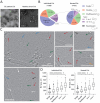Distinctive Features of Extracellular Vesicles Present in the Gastric Juice of Patients with Gastric Cancer and Healthy Subjects
- PMID: 40565320
- PMCID: PMC12193056
- DOI: 10.3390/ijms26125857
Distinctive Features of Extracellular Vesicles Present in the Gastric Juice of Patients with Gastric Cancer and Healthy Subjects
Abstract
Extracellular vesicles (EVs) are key mediators of intercellular communication and play a vital role in cancer progression. While EVs in the blood are well-studied, those in local body fluids, such as gastric juice (GJ), remain underinvestigated. Previously, we first characterized GJ-derived EVs and demonstrated their potential for gastric cancer (GC) screening. Here, we conducted a detailed morphological analysis of GJ-EVs using cryo-electron microscopy, identifying both typical and atypical EV subtypes, and categorized their relative abundances. A subsequent comparison of the size distribution of GJ-derived EVs by nanoparticle tracking analysis revealed significant differences between samples obtained from GC patients (n = 40) and healthy subjects (n = 25). Additionally, the mean EV sizes differed significantly according to the presence of the tetraspanin protein CD9. Furthermore, the ratio of CD9-positive to CD9-negative EV samples differed between cancer patients and healthy donors. These data suggest that GJ contains distinct subpopulations of EVs that vary in size and CD9 expression, as well as EVs with certain types of atypical morphology. The identification of discrepancies in EV size and the presence of CD9 between GJ from cancer patients and healthy individuals offers potential avenues for the identification of new GC markers.
Keywords: CD9; cryo-electron microscopy; exosomes; gastric cancer; gastric juice; nanoparticle tracking analysis; small extracellular vesicles; tetraspanins.
Conflict of interest statement
The authors declare no conflicts of interest.
Figures





Similar articles
-
Tetraspanin Positivity as a Function of Extracellular Vesicle Size Measured by a Modified Immuno-TEM Protocol.ACS Appl Bio Mater. 2025 Aug 18;8(8):6843-6853. doi: 10.1021/acsabm.5c00591. Epub 2025 Jul 16. ACS Appl Bio Mater. 2025. PMID: 40669512
-
Phenotyping extracellular vesicles and their serotonin transporter cargo in major depressive disorder.J Affect Disord. 2025 Nov 15;389:119740. doi: 10.1016/j.jad.2025.119740. Epub 2025 Jun 21. J Affect Disord. 2025. PMID: 40550277 Clinical Trial.
-
Exhaled breath condensate contains extracellular vesicles (EVs) that carry miRNA cargos of lung tissue origin that can be selectively purified and analyzed.J Extracell Vesicles. 2024 Apr;13(4):e12440. doi: 10.1002/jev2.12440. J Extracell Vesicles. 2024. PMID: 38659349 Free PMC article.
-
Analysis of biomarkers in speculative CNS-enriched extracellular vesicles for parkinsonian disorders: a comprehensive systematic review and diagnostic meta-analysis.J Neurol. 2024 Apr;271(4):1680-1706. doi: 10.1007/s00415-023-12093-3. Epub 2023 Dec 16. J Neurol. 2024. PMID: 38103086 Free PMC article.
-
A promising future for endometriosis diagnosis and therapy: extracellular vesicles - a systematic review.Reprod Biol Endocrinol. 2022 Dec 21;20(1):174. doi: 10.1186/s12958-022-01040-y. Reprod Biol Endocrinol. 2022. PMID: 36544197 Free PMC article.
References
MeSH terms
Substances
Grants and funding
LinkOut - more resources
Full Text Sources
Medical
Miscellaneous

